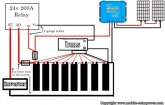Starry-Nights
New Member
- Joined
- Nov 4, 2019
- Messages
- 23
I have a eight 100 amp 3.2V LiFeP04 cells connected as a 100 amp 24V battery with a Daly 8S 24V 200amp BMS. I also have a 3000W / 9000W surge Inverter Charger. The BMS has 6 AWG cables which seem nowhere near the required 1/0 AWG minimum for the inverter. I at first thought of connecting the inverter directly to the battery, and not through the BMS first, but that would seem it could make the BMS completely bypassed. I have looked at some other BMS's but the cables on them seem pretty wimpy too. Suggestions, simple wiring diagram greatly appreciated!
One additional related question: I am using a Epever 30Amp MPPT and live in NH where the temps have starting dropping into the 20's at night. The controller has a Temp sensor, but I can find no setting to stop charging when temp goes below freezing. The Daly BMS does not seem to have this capability either. To handle, I have installed a simple thermostat the cuts the solar array off at 34 degrees and resumes and 37. It has a 20 amp relay and it works great for the solar (four 100W panels, configured as 24V), but would not work for the higher amps of the inverter/charger. Additionally, I have a 12V to 24V Sterling Battery to Battery unit I have yet to install that can supply up to 70 amps.
One additional related question: I am using a Epever 30Amp MPPT and live in NH where the temps have starting dropping into the 20's at night. The controller has a Temp sensor, but I can find no setting to stop charging when temp goes below freezing. The Daly BMS does not seem to have this capability either. To handle, I have installed a simple thermostat the cuts the solar array off at 34 degrees and resumes and 37. It has a 20 amp relay and it works great for the solar (four 100W panels, configured as 24V), but would not work for the higher amps of the inverter/charger. Additionally, I have a 12V to 24V Sterling Battery to Battery unit I have yet to install that can supply up to 70 amps.




